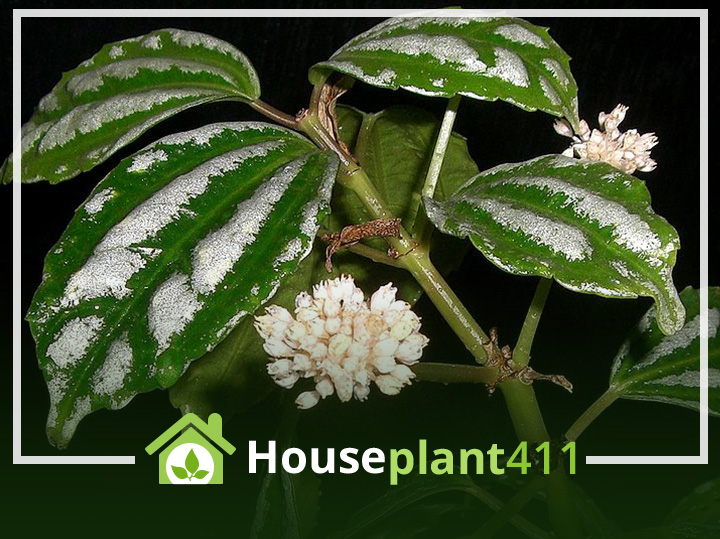Pilea Plant Description:
The pilea plant, a member of the nettle family, is an attractive hanging or table plant native to China and Viet Nam. There are many different types of pilea plants, and all are easy to grow, even for a new plant enthusiast. One of the easiest to care for is the Aluminum plant (Pilea Cadierei) also called the Watermelon Pilea. This variety is grown for its attractive leaves rather than its very small, white flowers. The dark green, oval, puffy foliage has distinct, shiny, silver markings on the upper side of the leaf that look like someone splashed aluminum colored paint on it. The leaves on an Aluminum plant are usually about 3” (7.6cm) long and the height of the plant 6″ to 12″ inches (15-31 cm.). All pilea plant varieties are small, soft- stemmed plants, the tallest usually no more than 12″-18″ (30-45 cm) tall. Pilea plants need to be pruned frequently if you want them to stay full and bushy and not become leggy and bare looking.
Pilea Plant Varieties
Although the “Aluminum” Pilea plant is the most popular type, there are several other Pilea plant varieties that make beautiful houseplants.
Artillery Plant (Pilea microphylla) resembles a fern with tiny, oval to rounded succulent, light green leaves (1/4” to 1/2” long).
Moon Valley Pilea (Pilea involucrata “Mollis”) is a bushy plant that got it name because the leaves, yellow green with dark copper veins and undersides, were thought to resemble the craters and valleys on the moon.
Norfolk Friendship Plant (Pilea involucrata ‘Norfolk’ Angel Wings) has ovate (oval), furrowed leaves that start out reddish pink and gradually turn a bronze/red with splashes of metallic silver.
Chinese Money Plant also called a Coin plant or Pancake plant because of its bright green coin shaped leaves.
Pilea ‘Dark Mystery’ has long, serrated, dark green/brown textured leaves with a silver line down the center of each leaf.
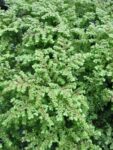
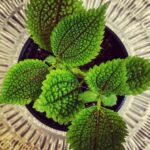
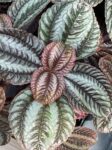
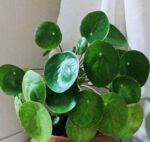
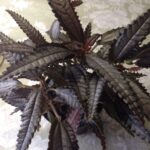
Artillery Plant Moon Valley Norfolk Friendship Chinese Money Dark Mystery
Quick Care Tips
Prune frequently and aggressively
Roots grow quickly so repot annually
Keep in a warm in temperatures above 55°F (12.8C)
Provide bright light but avoid direct sun
Keep the soil barley moist except in winter when it needs to dry out a bit more
The beauty of a pilea plant lies in the texture and color in the tops of the leaves, so always place the plant where that can be easily seen.
Plant Care
Light
How much light does a pilea plant need: A pilea plant needs bright indirect light. Direct sun burns the very attractive leaves and insufficient light causes the plant to become leggy as it stretches for more light.
Water
How to water a pilea plant: Keep the soil of a pilea plant slightly moist, but not soggy at all times. During the cooler months or when your pilea plant is not producing new leaves, allow the top 2-3 inches of soil to dry out before watering.
Fertilizer
How to fertile a pilea plant: Feed a pilea plant every two weeks when it is actively growing with a balanced plant food diluted to 1/2 the recommended strength.
Temperature
Best temperature for a pilea plant: This plant likes to be warm all of the time. The best temperature for a pilea plant is 60°-75°F ( 18.3°-23.9°C).
Humidity
Humidity for a pilea plant: A pilea plant require very high humidity to keep the leaves looking beautiful. If your home is dry, place the plant on a tray of pebbles filled with water. Be sure the plant is sitting on the pebbles and not in the water.
Flowering
Does a pilea plant flower: A pilea plant produces very small flowers that are over- shadowed by its lovely, distinctive looking leaves.
Pests
Pilea plant pests: Spider mites, aphids, fungus gnats, scale, and thrip can all be a problem for a pilea plant. See a picture and read how to identify and treat these plant pests in the Glossary of the website.
Diseases
Pilea plant diseases: Because of the high humidity a pilea requires, both bacterial and fungal Leaf Spot disease are a problem. Prevent this disease by keeping the leaves dry ((do not mist a pilea plant) and providing good air circulation around the plant. Read more about how to identify and treat Leaf Spot disease in the Glossary of the website.
Soil
Right soil for a pilea plant: Use a loose, airy soil that drains quickly for a pilea plant. Add peat moss or other organic matter to a commercial houseplant soil to plant your pilea plant develop a good root structure.
Pot Size
Pot size for a pilea plant: A pilea plant is one of the few houseplants that do not like to be root-bound. The roots of a pilea plant grow very quickly so check annually to see if the plant needs a larger container.
Pruning
How to prune a pilea plant: A pilea plant must be frequently and aggressively pruned to prevent it from becoming leggy and unattractive. You can use the cutting to propagate new plants.
Propagation
How to propagate a pilea plant: A pilea plant is easily propagated using stem cuttings. Read detailed instructions on how to use stem cuttings to propagate your plants in the Glossary of the website.
Resting Period
Does a pilea plant have a resting period: A pilea plant becomes dormant in the winter. During this time, the plat needs less water.
Poisonous Plant Info
Is a pilea plant poisonous: A pilea plant is a non-poisonous plant and safe to have around children, cats, dogs, and other pets.
FAQ
If a pilea is damaged by the cold, it will drop all of its leaves. However, if you cut back the damaged stems, new growth quickly develops once you move it indoors to a warm bright spot.
The brown spots on the leaves of your pilea are caused by Leaf Spot Disease. Leaf Spot often affects indoor plants that require high humidity. Remove the diseased leaves, keep water off of the healthy leaves, do not mist the plant, and provide good air circulation around the plant. If the Leaf Spot Disease persists, get rid of the plant before the disease spreads to other plants.
The leaves on your pilea are wilted and turning a funny color because you are watering it during the winter the same way you watered it in the summer. As the weather gets cooler, you need to water a pilea and most houseplants less since they are not growing very much. Allow the soil to dry out and see if any new shoots appear, hopefully a few roots are still alive.

